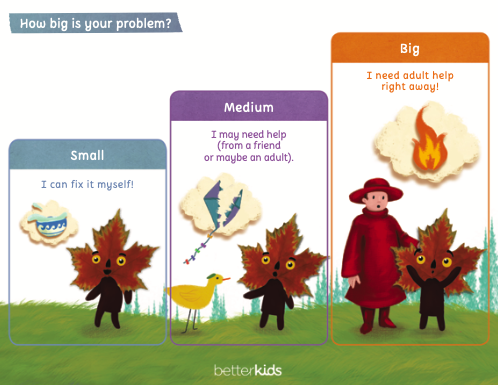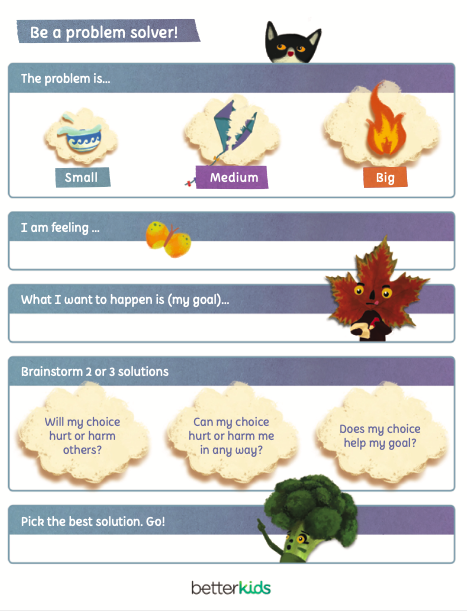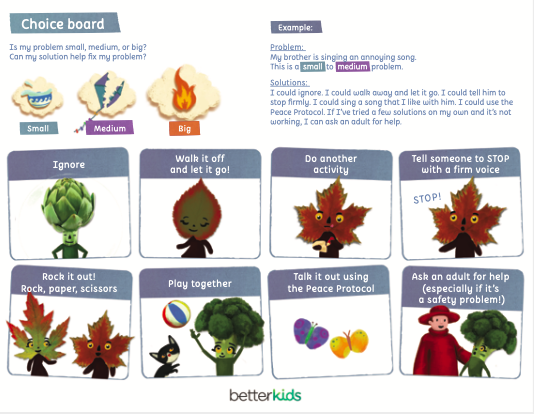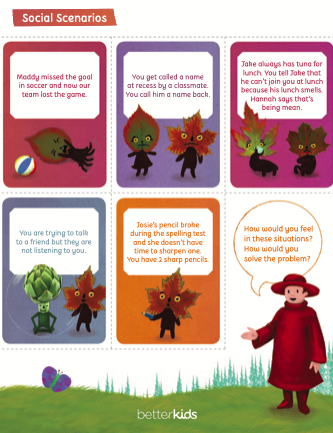As kids are changing and growing, they are figuring out the balance of requesting help and acting independently, while negotiating what is and isn’t acceptable behavior in given circumstances. This can be a tricky world to navigate. When problems arise, children’s big feelings can sometimes be consuming and affect their ability to make what we adults deem to be responsible decisions. And sometimes when they are overwhelmed with emotions, their immediate reactions can lead to many unintended consequences that don’t actually solve the original problem, but add to the frustration. Adults can empower children to solve problems responsibly and with time, children will be able to independently develop their own thinking processes for solving problems.
But first, what does responsible problem solving mean? This has to do with one’s ability to make choices about our personal behavior based on safety, ethics, and social norms. In simple, kid-friendly terms - When you have a problem, do the choices you make hurt or harm others or yourself? Are your choices fair to others? Do they show caring?
Provide some structure for your child and guide them through these steps as a way to approach future situations.
Responsible Problem-Solving
1. Identify the problem
Is this a small, medium, or big problem?
Categorizing the magnitude of problems can be a weighty enough topic to be its own separate discussion and lesson. Younger children, with less life experience, generally have a harder time with perspective taking. And for others who are still developing in their maturity, their small problems (or mole hills) can still feel like mountains to conquer. We as adults have a responsibility to instill habits and behaviors that allow children to face challenges with more ease. We don’t want them to struggle with overwhelming emotions over the smaller obstacles that inevitably occur throughout the day. And so in that vein, we want to teach them that the size of the reaction should correspond to the size of the problem.
This mini-lesson can lead to making decisions more responsibly but also effectively.
To help ground their understanding, offer concrete examples, especially ones that are most relevant and meaningful to their life. You could brainstorm different problems from the past and work together to categorize and discuss those scenarios!
An easy way for children to remember is ...
SMALL
I can fix it myself!
Example:
I broke my pencil. I can fix it myself by finding the pencil sharpener or I can use another pencil or writing tool.
I am standing in line and someone bumps into me from behind.
MEDIUM
I may need help
(from a friend or maybe an adult).
Example:
I spilled my juice on the floor. I can try to clean it myself but I may need someone to help if the mess is big or sticky.
I am playing a board game and I’ve lost 3 times in a row.
BIG
I need adult help right away.
Example:
Someone pushed me really hard and I fell down and scraped my knee.
I am playing on the playground and a growling dog is running over.
2. Acknowledge the feeling
Once the size of the problem is identified with some perspective taking, it’s good to acknowledge that no matter the magnitude of the issue, it still affects how a child feels. Check in - Are they frustrated? Sad? Angry with a friend?
3. Name the desired goal
In other words, what do they want to happen? Does the child want to make up with their friend? Do they want to replace what is broken? Do they want to feel happier, and not sad anymore?
4. Brainstorm 2 - 3 solutions
It’s important to have the child consider these questions...
Will my choice hurt or harm others?
Will my choice hurt or harm myself?
Does my choice help my goal?
5. Pick a solution!
Pick the solution that best meets the criteria from Step 4.
As with any routines or expectations, responsible problem solving takes time, practice, and guidance from adults. It can be helpful to think through some memories and have your child act them out again. How would they evaluate their past reactions or solutions? What different decisions could they make if there was a redo? Using your personal knowledge of your child’s personality and areas of growth, you could also generate some likely scenarios for your child to review and discuss, or go ahead and choose from these printable cards that can be turned into a deck. A visual step by step flowchart to stick on the fridge, in their room, or in their go to calm spot can also be a helpful reference when they’re facing a challenge. Finally, children may need help brainstorming potential solutions - this printable problem-solving choice board could be a good place to start as they begin to build their toolbox of strategies.
Problem solving is foundational to a child’s learning capacity and their ability to face future roadblocks independently. Whenever possible, don’t swoop in for the rescue, but help facilitate these decision making processes with a positive attitude and encourage your child to make their own choices. Keep in mind that the best solution may not always be picked and those mistakes are part of the equation. We should allow it to enable learning! With guidance and patience, children will grow in their ability to solve problems responsibly.






